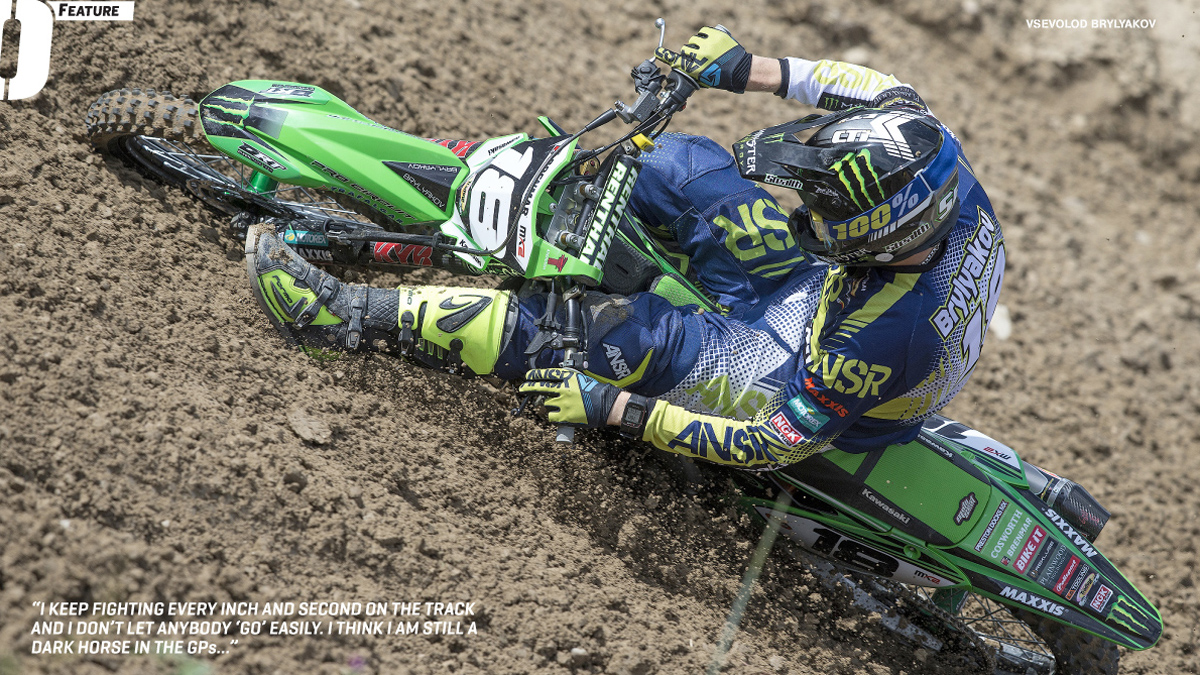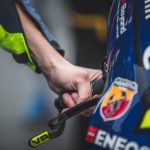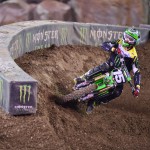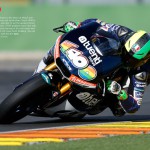Many people had difficulty to pronounce the name of the rider that Steve Dixon’s Monster Energy DRT Kawasaki team decided to take a punt on for 2016. After some peachy times with Zach Osborne, Dean Ferris and Max Anstie in MX2, Dixon eyed two ventures this season: resurgence with Tommy Searle, and some more of his development/elevation magic with a younger prospect. Twenty year old Russian, Vsevolod Brylyakov has already caused a stir just five Grands Prix into his term with the British crew and his fourth in MX2. Where did he come from? What’s his story and how has Dixon done it again?
‘Brylyakov’ is a name that has hovered around Grand Prix for a couple of years and been submerged in that strange and fluctuating mid-group in MX2 that combine emerging talent, riders struggling to breakthrough, those on the fast-track, wealthy aspirants and relentless hopefuls. Slight, fair-headed and with a loose and barrelling riding style that indicated that ‘18’ was one of the harder-edged competitors ‘Seva’ was still however hard to notice as injuries largely meant he was dipping in and out of the class. A Honda rider for 2014-15 it was last year that he finally matured in terms of strength, fitness and confidence (talking to Seva in his excellent English it is clear that he is an level-headed athlete, independent and used to managing many areas of his life singlehandedly) to push that surname into top five prominence. It was in the middle of ’14 when the Dixon operation first had a blip on their radar.
“I first saw him at Teutschenthal [Germany] in 2014,” recounts Ashley Kane who describes himself as a Jack-of-all-trades for the team but has been one of Dixon’s closest confidants for a number of years and fills an important, unofficial consultancy role. One that was responsible for Osborne, Ferris and Anstie coming into the set-up and helped nurture the potential that Billy Mackenzie showed in the Noughties. “I was watching the riders come through the section that goes past the pitlane and thought ‘who’s that?!’ He just had that bit of aggression and determination that caught the eye. He must have finished eighteenth or nineteenth that weekend [he was fourteenth overall] but I had already looked on the results sheets to see the name and number. He just didn’t seem to give up, and I mentioned him to Steve that day actually. He didn’t post the results but we saw the potential.”
A year later and in the same mid-season period Dixon was coming to terms with Max Anstie’s decision to end a two-year association and move to factory Husqvarna for this final MX2 tilt for 2016. Weeks later and Brylyakov would start to create some momentum. A fourth place at the Grand Prix of Sweden would be the highlight until he wrecked his shoulder at Kegums in Latvia and it largely snuffed his progress. A dispute with his current J-Tech team meant his future was briefly uncertain. Dixon and Kane had already decided to make an approach.
“We were not worried about Seva coming in and having to follow Max, we figured that getting a rider like Tommy would take care of the limelight – so to speak – while we thought that we could work with Seva and grow with him; Ash spotted him and then we saw a good project,” recounts Dixon.
“We haven’t really had the budget to match the bigger teams so we have to look and spend wisely,” voices Kane. “The team has a good record, but it has become more and more competitive [to find talent] in the last ten years because riders are much more switched on when it comes to training and getting the physical side of the job right; there has been a lot of input from specialists, more than before. So getting it right in choosing a rider has become more difficult.”
“It is easy to spend and go and buy a rider that can fight for Grand Prix wins but if you give a rider the right set-up – and Steve builds a very good motorcycle – and dedicated staff then you will really see what people can do,” he continues. “It is a very fine line between a rider who can reach the top five and another that can push for podiums and more.”
“Of course, we are constantly looking and watching,” he adds. “I was in Valkenswaard checking out the European classes and also MX2. Also the Australian nationals. You cannot limit your scope, motocross is a global sport and it should be treated globally. Brylyakov was a great move for us and the right one at the right time.”

We actually meet Seva in former rider-and-now trainer Chris Hay’s house in California. It is early in the supercross season and Brylyakov is in the States with Searle and other members of DRT sorting their pre-GP prep in the run-up to Qatar.
He’s quiet, almost a little shy and is clearly trying to feel his way into a British group after having been based among Italians (Gariboldi and J-Tech) for the last three years. We grab some photos and have a chat and then later sit down for a more formal conversation in the paddock of the San Diego SX and outside the vast walls of Petco Park.
Seva might be adept with his English (“he has a better sense of humour than I thought he would,” says Dixon) but he actually takes time to think about his answers and it’s a refreshing conversation (“I thought he was polite and down to earth,” says Kane. “I thought he was very grounded and knew what he wanted; you can tell quite a lot through first impressions.”). If he continues to surprise with his riding and results (a first podium is already in the bag) then his voice will become far more prevalent as 2016 rolls on and onto next year when athletes like Alex Tonkov, Anstie, Herlings move out of MX2 and Brylyakov will be running at the forefront.
2015 ended quite abruptly for you. Was it frustrating to get that injury because it seemed like other teams and a lot of people were starting to look at the momentum you were gathering…?
Very disappointing because I was making the results and starting to close-in on the podium in GPs and the shoulder injury effectively kicked me out of competition and definitely out of the top five.
The shoulder can also be a complicated joint to fix…
The problem we had was a broken ligament and the Acromion bone came out. I also had problems around my ribs and it was a strange injury. It took a lot of recovery time and I was two months in a sport medical centre in Russia. It was the longest period of treatment I had ever done and it was strange to deal with. I’ve had normal fractures and broke my back one but the problem with this one was that I didn’t really feel that I had to stay away from the bike. I was still racing in Lommel and in the Czech Republic…but eventually had to walk away because I didn’t have the strength to make the results. You always have to be 100% for GPs.
How did you initially get to Europe?
I was a kid! And the first time was in 2006 when I was riding 65s. I had some good results in the European Championship and was second, fighting for the title and then had a few seasons out. I was back in 2010 with the Suzuki International team and fighting for a European title again with people like Tim Gajser and Brian Bogers and every season after that I was trying to find some way to stay here; some sponsors or teams that would help me keep going. It was difficult for a Russian kid because we come from far away, we have to stay away from home a long time and not many teams believed in Russians at that moment. I’ve been living on my own since I was fifteen. I’m used to training just with my mechanic and doing my physical work alone. I’m lucky to have a guy, Roberto Manzaroli, in Italy helping on the personal training side and with working during pre-season. Most of the time I’m by myself washing, cooking, cleaning. In the beginning it was a bit complicated but you get used to it.
Read the rest of the article in the new OTOR by clicking HERE








